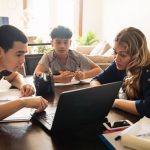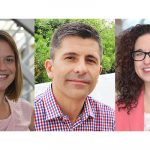Looking for an inspiring discussion of creativity and its potential? In this episode, Joe Binetti talks to renowned creativity expert Professor James C. Kaufman of the University of Connecticut, who co-developed the influential Four-Cs model of creativity – amongst many other things.
“Jack was known for many contributions to our field but especially his passionate commitment to our organization, his many talented doctoral students, and his innovative survey of trends in reading, the annual What’s Hot, What’s Not study. He was a friend to everyone in the literacy community and will be missed by us all. I will always remember his wide, welcoming smile each and every time we met.” —Donald J. Leu, University of Connecticut
Educational Psychology Professor Joseph Madaus and Literacy Education Professor Rachael Gabriel are part of a team that will provide several resources, workshops, and tools to neurodiverse graduate students to improve their success in graduate programs and give them skills that prepare them for careers in academia and business.
Through the help of Zaghi, Hain, Civil Engineering Professor Richard Christenson, Educational Psychology Professor Joseph Madaus, English Professor Tom Deans, and Literacy Education Professor Rachael Gabriel, the team will be developing a strength profiler tool, creating a peer mentoring program, piloting a technical writing program, and holding stakeholder workshops.
Neag School students completing the UConn Administrator Preparation Program (UCAPP) this spring recently presented their capstone projects – the program’s signature final assignment in which students identify a need or opportunity for school improvement and work toward positive change. The UCAPP program went through a redesign in 2020 as part of a nationwide effort known as the University Principal Preparation Initiative (UPPI), funded by the Wallace Foundation. As a result of the redesign, the concept of family and parent engagement became a priority for the first organizational leadership course in UCAPP’s program of study.
This is not the end, it’s the beginning. That was the message from U.S. Secretary of Education Miguel Cardona ’01 MA, ’04 6th Year, ’11 Ed.D., ’12 ELP to UConn’s 2021 graduates, delivered Saturday, May 8 via video during the livestreamed commencement ceremony for all students receiving degrees this year – undergraduate, graduate, and professional.
Throughout the academic year, the Neag School is proud to share the latest achievements of its faculty, staff, students, and alumni. Explore their most recent promotions, awards, retirements, publications, and more.
A group of UConn researchers have received a $2.5 million grant from the National Institutes of Health (NIH) to develop a network to address knowledge gaps on the topic of emotional well-being, an emerging public health concern. This project is one of six, totaling more than $3.13 million in year one funding from the NIH.
As the world of science, technology, engineering, and math (STEM) becomes increasingly computational, promoting students’ computational thinking is essential to prepare them for future STEM careers. Neag School of Education assistant professor of learning sciences, Ido Davidesco, has received a $1.4 million grant from the National Science Foundation (NSF) to develop a month-long computational thinking unit in high school biology classes.
Neag School assistant professor of learning sciences, Ido Davidesco, has received a $1.4 million grant from the National Science Foundation to develop a month-long computational thinking unit in high school biology classes. Davidesco will work with Neag School colleagues Bianca Montrosse-Moorhead, Christopher Rhoads, and John Settlage, as well as Aaron Kyle from Columbia University’s Department of Biomedical Engineering.





